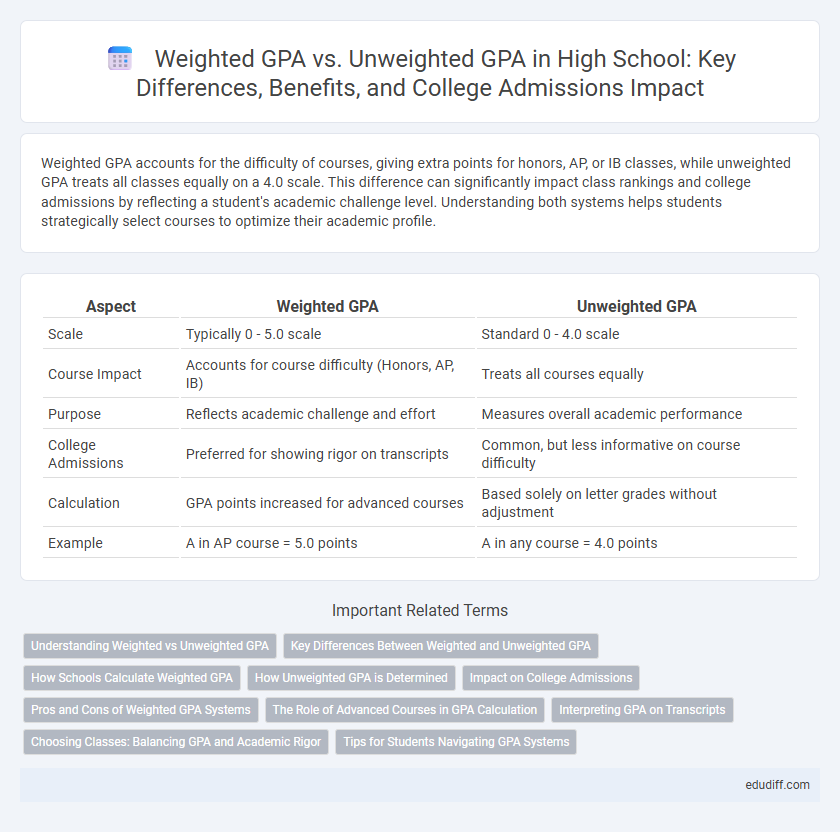Weighted GPA accounts for the difficulty of courses, giving extra points for honors, AP, or IB classes, while unweighted GPA treats all classes equally on a 4.0 scale. This difference can significantly impact class rankings and college admissions by reflecting a student's academic challenge level. Understanding both systems helps students strategically select courses to optimize their academic profile.
Table of Comparison
| Aspect | Weighted GPA | Unweighted GPA |
|---|---|---|
| Scale | Typically 0 - 5.0 scale | Standard 0 - 4.0 scale |
| Course Impact | Accounts for course difficulty (Honors, AP, IB) | Treats all courses equally |
| Purpose | Reflects academic challenge and effort | Measures overall academic performance |
| College Admissions | Preferred for showing rigor on transcripts | Common, but less informative on course difficulty |
| Calculation | GPA points increased for advanced courses | Based solely on letter grades without adjustment |
| Example | A in AP course = 5.0 points | A in any course = 4.0 points |
Understanding Weighted vs Unweighted GPA
Weighted GPA accounts for the difficulty of courses by assigning extra grade points for honors, Advanced Placement (AP), or International Baccalaureate (IB) classes, often exceeding the standard 4.0 scale. Unweighted GPA calculates grades on a fixed 4.0 scale regardless of course difficulty, providing a straightforward measure of academic performance. Understanding the differences between weighted and unweighted GPA helps students and colleges assess academic rigor alongside overall achievement.
Key Differences Between Weighted and Unweighted GPA
Weighted GPA accounts for course difficulty by assigning extra points to honors, AP, or IB classes, potentially raising the scale above the standard 4.0. Unweighted GPA reflects a straightforward average based solely on letter grades without considering course rigor, capped at a 4.0 scale. This distinction significantly impacts college admissions, as weighted GPAs highlight academic challenge, while unweighted GPAs provide a uniform comparison across students.
How Schools Calculate Weighted GPA
Schools calculate weighted GPA by assigning extra grade points to honors, Advanced Placement (AP), and International Baccalaureate (IB) courses, typically on a 5.0 or 6.0 scale instead of the standard 4.0 scale used for regular classes. This system rewards students for taking more challenging coursework, reflecting both the difficulty of classes and academic achievement. Weighted GPAs can vary between schools, depending on the weighting scale and which courses qualify for weighting.
How Unweighted GPA is Determined
Unweighted GPA is determined by assigning a standard 4.0 scale where an A equals 4.0, B equals 3.0, C equals 2.0, D equals 1.0, and F equals 0.0, regardless of course difficulty. Each course grade is converted to this scale, and the average is calculated by dividing the total grade points by the number of classes taken. This method reflects a student's overall academic performance without factoring in honors or Advanced Placement (AP) course weight.
Impact on College Admissions
Weighted GPA reflects course difficulty by assigning extra points for honors, AP, or IB classes, often exceeding the standard 4.0 scale, which can enhance a student's academic profile. Unweighted GPA represents the average of grades on a 4.0 scale without accounting for course rigor, offering a straightforward measure of academic performance. College admissions officers evaluate both GPAs to assess not only overall achievement but also the challenge level students undertake, with weighted GPA providing insight into academic ambition and preparedness.
Pros and Cons of Weighted GPA Systems
Weighted GPA systems offer the advantage of recognizing academic rigor by assigning extra points to honors, Advanced Placement (AP), and International Baccalaureate (IB) courses, which can boost students' grade point averages beyond the standard 4.0 scale. This can incentivize students to challenge themselves with more difficult coursework and strengthen their college applications. However, weighted GPAs may create disparities among students from different schools or districts due to inconsistent weighting policies and can sometimes obscure true academic performance by inflating grades.
The Role of Advanced Courses in GPA Calculation
Advanced courses such as AP, IB, and honors classes significantly influence weighted GPA calculations by assigning extra points to grades, often on a 5.0 or higher scale, compared to the standard 4.0 scale used in unweighted GPA. This system rewards academic rigor and can enhance a student's overall GPA, reflecting greater course difficulty and better preparing students for college admissions. Schools use weighted GPAs to distinguish students who challenge themselves with advanced coursework from those with standard course loads.
Interpreting GPA on Transcripts
Weighted GPA reflects the difficulty of courses by assigning extra points for honors, AP, or IB classes, whereas unweighted GPA treats all classes equally on a 4.0 scale. When interpreting transcripts, admissions officers consider weighted GPA to assess a student's willingness to challenge themselves academically and differentiate among students with similar unweighted GPAs. Understanding both GPA types helps provide a clearer picture of academic performance and rigor.
Choosing Classes: Balancing GPA and Academic Rigor
Weighted GPA accounts for the difficulty of advanced classes such as AP or honors courses, which can boost overall GPA beyond the standard 4.0 scale of unweighted GPA. Choosing classes requires balancing the challenge of rigorous coursework with the potential impact on both weighted and unweighted GPAs to maintain a competitive academic record. High school students should consider their academic goals and college admissions criteria when selecting courses to optimize their GPA and transcript strength.
Tips for Students Navigating GPA Systems
Students should understand that a weighted GPA accounts for course difficulty, giving extra points for honors, AP, or IB classes, while an unweighted GPA reflects a straight scale without such adjustments. Prioritizing rigorous coursework can boost a weighted GPA, but maintaining strong grades across all classes is essential for both metrics. Keeping track of individual school policies on GPA calculation helps students strategically select classes and set realistic academic goals.
Weighted GPA vs Unweighted GPA Infographic

 edudiff.com
edudiff.com